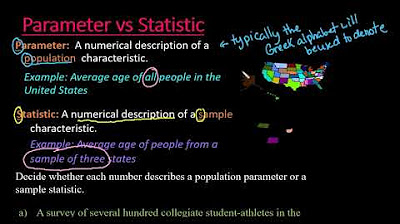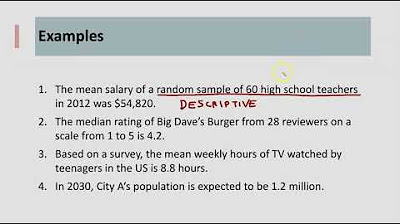DIFFERENCE BETWEEN PARAMETER AND STATISTIC | STATISTICS AND PROBABILITY | TAGLISH
TLDRThis informative video script discusses the key differences between a parameter and a statistic in the context of data analysis. It uses clear examples to illustrate how parameters represent population data, while statistics summarize sample data. The script effectively engages viewers by prompting them to consider whether various data points are parameters or statistics, enhancing their understanding of these fundamental concepts in statistical analysis.
Takeaways
- 📊 A parameter is a characteristic or measure derived from the entire population's data set.
- 🔍 A statistic is a numerical summary or estimate based on a sample of the population data.
- 🎯 In a national survey, the percentage of respondents reporting a certain behavior (e.g., drug use among 12-17 age group) is a parameter.
- 🏆 An individual's career achievement (e.g., Ty Cobb's batting average) represents a statistic of that single individual's performance.
- 📈 A study's finding on a large group (e.g., 6,076 adults in public restrooms) is considered a parameter if it refers to the entire group surveyed.
- 🔢 An interview or survey result (e.g., 100 adults knowing the minimum age for presidency) is a statistic if it's based on a sample of the population.
- 📚 The average grade of a class (e.g., from a teacher's record) is a statistic as it's based on a specific group of students.
- 🏭 A micro business's long-term average production (e.g., 800 backpacks per month over eight years) is a parameter because it refers to the entire period of operation.
- 🌐 The script emphasizes the importance of distinguishing between parameters, which are population-wide, and statistics, which are sample-based.
- 🔑 Understanding the difference between parameters and statistics is crucial for accurate data analysis and interpretation.
- 📋 The examples provided in the script serve as a guide to help listeners identify whether a given data point is a parameter or a statistic.
Q & A
What is the main topic of the video?
-The main topic of the video is the difference between a parameter and a statistic.
How does the video define a parameter?
-A parameter is a characteristic or number that summarizes data from an entire population.
How does the video define a statistic?
-A statistic is a number that summarizes data from a sample of a population.
What is an example of a parameter given in the video?
-An example of a parameter in the video is the percentage of adolescents in a population of 50,000 Filipinos.
What is an example of a statistic given in the video?
-An example of a statistic in the video is the percentage of students from a sample of 200 who come from broken families.
How does the video differentiate between a parameter and a statistic in the context of a national survey on substance abuse?
-The video considers the percentage of respondents aged 12-17 who reported using illicit drugs as a parameter because it refers to the entire population of the national survey.
What is the significance of the career batting average of Ty Cobb in the discussion?
-Ty Cobb's career batting average of 0.366 is used as an example of a statistic because it summarizes his performance as an individual player, not the entire population of baseball players.
How does the video classify the finding that 23 percent of 6,076 adults in public restrooms in major Philippine cities did not wash their hands?
-The video classifies this finding as a parameter because it refers to a large, specific group of people in the major cities of the Philippines.
What is the difference between the statistic of 44 percent of 100 adults who knew the minimum age required for the office of the Philippine president and the parameter of 800 backpacks produced per month by a micro business?
-The 44 percent is a statistic because it is based on a sample of 100 adults, while the production of 800 backpacks per month is considered a parameter because it refers to the consistent performance of the micro business over eight years.
Why is the average math grade of students gathered by a mathematics teacher considered a statistic in the video?
-It is considered a statistic because it is based on a sample of students' grades from the teacher's class, not the entire population of students.
How does the video emphasize the importance of understanding the difference between parameters and statistics?
-The video emphasizes that understanding the difference is crucial for accurate data analysis and interpretation, as it helps distinguish between conclusions drawn from a complete set of data (parameters) and those from a subset of data (statistics).
Outlines
📚 Introduction to Parameters and Statistics
The paragraph begins with an introduction to the topic of the video, which is the difference between parameters and statistics. It emphasizes the importance of engaging with the content by encouraging viewers to like, subscribe, and turn on notifications for the channel. The speaker also mentions the variety of subjects available on the channel and reminds viewers to watch the ads for the video. The main focus of the paragraph is to define parameters as population data that summarize information from an entire population, using the example of adolescents in the Philippines. Statistics, on the other hand, are defined as sample data that summarize information from a sample, illustrated with the example of students from a particular school. The speaker uses these examples to highlight the distinction between parameters and statistics, setting the stage for further discussion and examples in the video.
🔍 Examples to Distinguish Parameters from Statistics
This paragraph delves into specific examples to clarify the difference between parameters and statistics. It starts with a national survey on substance abuse, where 10% of respondents aged 12 to 17 reported using illicit drugs, identifying this as a parameter since it refers to an entire age group in the country. The paragraph then discusses Ty Cobb's career batting average in Major League Baseball as a statistic, as it is a single individual's data. A study on handwashing habits in public restrooms in major Philippine cities is also presented as a parameter, as it involves a large population. The paragraph continues with an interview of 100 adults about the minimum age for the Philippine presidency, which is a statistic due to the small sample size. Lastly, it mentions a mathematics teacher's average grade calculation for students and a micro business's average backpack production as statistics and parameters, respectively. The paragraph concludes with a summary of the key points discussed, reinforcing the understanding of the differences between parameters and statistics.
Mindmap
Keywords
💡Parameter
💡Statistic
💡Population
💡Sample
💡National Survey
💡Batting Average
💡Public Restrooms
💡Minimum Age
💡Math Grade
💡Micro Business
💡Average Production
Highlights
The main topic discussed is the difference between a parameter and a statistic.
A parameter is a characteristic or measure of an entire population's data.
A statistic is a characteristic or measure of a sample's data.
An example of a parameter is the percentage of adolescents in a population of 50,000 Filipinos.
An example of a statistic is the percentage of students from a sample of 200 who come from broken families.
National surveys, like the one on substance abuse among 12-17 year olds, provide parameter data.
Individual data points, such as Ty Cobb's career batting average, are considered statistics.
A study involving a large group, like 6,076 adults in public restrooms, yields parameter data.
Interviews with a smaller group, such as 100 adults, produce statistic data.
Data from a mathematics teacher averaging students' math grades is a statistic.
A micro business's average production over eight years is considered a parameter.
The distinction between parameter and statistic is crucial for understanding data analysis and interpretation.
Parameters and statistics are essential concepts in statistical studies and research.
Understanding the difference helps in accurately summarizing and making inferences from data.
The lecture provides clear examples to illustrate the difference between parameters and statistics.
The discussion on parameters and statistics is applicable across various fields and disciplines.
The lecture emphasizes the importance of correctly identifying whether a value is a parameter or a statistic.
The examples used in the lecture span from sports to public health and education, showcasing the broad relevance of the topic.
The lecture concludes by reinforcing the key difference between parameters and statistics.
Transcripts
5.0 / 5 (0 votes)
Thanks for rating:





